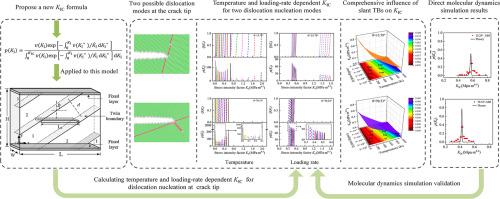Temperature and loading-rate dependent critical stress intensity factor of dislocation nucleation from crack tip: Atomistic insights into cracking at slant twin boundaries in Nano-twinned TiAl alloys
IF 11.2
1区 材料科学
Q1 MATERIALS SCIENCE, MULTIDISCIPLINARY
引用次数: 0
Abstract
This paper investigates the temperature and loading rate dependencies of the critical stress intensity factor (KIC) for dislocation nucleation at crack tips. We develop a new KIC formula with a generalized form by incorporating the atomistic reaction pathway analysis into Transition State Theory (TST), which captures the KIC of the first dislocation nucleation event at crack tips and its sensitivity to temperature and loading rates. We use this formula and atomistic modeling information to specifically calculate the KIC for quasi-two-dimensional crack tips located at various slant twin boundaries in nano-twinned TiAl alloys across a wide range of temperatures and strain rates. Our findings reveal that twinning dislocation nucleation at the crack tip dominates crack propagation when twin boundaries (TBs) are tilted at 15.79° and 29.5°. Conversely, when TBs tilt at 45.29°, 54.74°, and 70.53°, dislocation slip becomes the preferred mode. Additionally, at TB tilts of 29.5° and 70.53°, at higher temperatures above 800 K and typical experimental loading rates, both dislocation nucleation modes can be activated with nearly equal probability. This observation is particularly significant as it highlights scenarios that molecular dynamics simulations, due to their time scale limitations, cannot adequately explore. This insight underscores the importance of analyzing temperature and loading rate dependencies of the KIC to fully understand the competing mechanisms of dislocation nucleation and their impact on material behavior.

与温度和加载速率相关的裂纹尖端差排成核临界应力强度因子:对纳米孪晶 TiAl 合金斜孪晶边界开裂的原子论见解
本文研究了裂纹尖端位错成核的临界应力强度因子(KIC)与温度和加载速率的关系。通过将原子反应路径分析纳入过渡态理论(TST),我们开发了一种具有通用形式的新 KIC 公式,该公式捕捉了裂纹尖端第一个差排成核事件的 KIC 及其对温度和加载速率的敏感性。我们利用这一公式和原子模型信息,专门计算了纳米孪晶 TiAl 合金中位于各种斜孪晶边界的准二维裂纹尖端在各种温度和应变速率下的 KIC。我们的研究结果表明,当孪晶边界(TB)倾斜 15.79° 和 29.5° 时,裂纹尖端的孪晶位错成核主导了裂纹的扩展。相反,当孪晶边界(TB)倾斜 45.29°、54.74° 和 70.53°时,位错滑移成为首选模式。此外,当 TB 倾角为 29.5° 和 70.53° 时,在 800 K 以上的较高温度和典型的实验加载速率下,两种差排成核模式都能以几乎相等的概率被激活。这一观察结果特别重要,因为它强调了分子动力学模拟由于时间尺度的限制而无法充分探索的情况。这一洞察力强调了分析 KIC 的温度和加载速率依赖性的重要性,以充分了解差排成核的竞争机制及其对材料行为的影响。
本文章由计算机程序翻译,如有差异,请以英文原文为准。
求助全文
约1分钟内获得全文
求助全文
来源期刊

Journal of Materials Science & Technology
工程技术-材料科学:综合
CiteScore
20.00
自引率
11.00%
发文量
995
审稿时长
13 days
期刊介绍:
Journal of Materials Science & Technology strives to promote global collaboration in the field of materials science and technology. It primarily publishes original research papers, invited review articles, letters, research notes, and summaries of scientific achievements. The journal covers a wide range of materials science and technology topics, including metallic materials, inorganic nonmetallic materials, and composite materials.
 求助内容:
求助内容: 应助结果提醒方式:
应助结果提醒方式:


